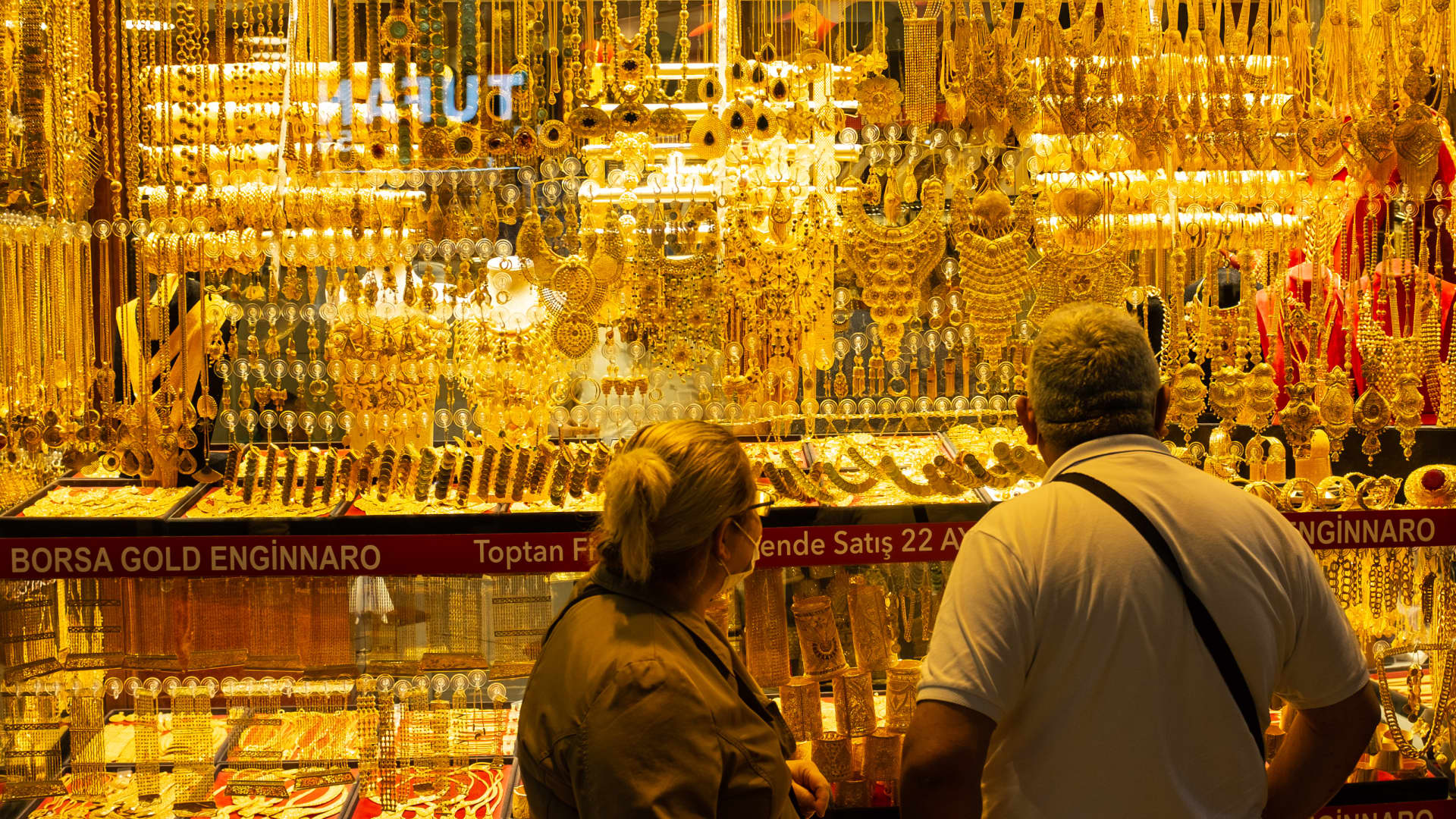People browsing gold jewelry in Istanbul.
Burak Kara | Getty Images News | Getty Images
Gold prices still have room to rise after hitting all-time highs early this month, as several central banks continue to purchase bullion in record amounts.
These purchases have strengthened gold prices despite high interest rates and a strong dollar, market watchers told CNBC.
Higher rates tend to reduce the appeal of gold compared with bonds as it does not pay any interest, while a stronger dollar erodes the sheen of greenback-priced bullion for holders of other currencies.
“Central banks, who have bought historic levels of gold over the past two years, continue to be strong buyers in 2024 as well,” World Gold Council Global Head of Central Banks Shaokai Fan said.
Strong physical demand for gold is also fueled by its appeal as a safe-haven asset amid geopolitical uncertainties.
“In the past decade, Russia and China have been the two largest buyers. However, central bank purchases in recent years have diversified,” Aakash Doshi, Citi’s North America head of commodities research, told CNBC.
China central bank top buyer
China is the leading driver for both consumer demand and central bank gold purchases, and the country’s not likely to slow down.
Among central banks, the People’s Bank of China was the largest buyer of gold in 2023. China’s weak economy and embattled real estate sector also drove more investors toward the safe-haven asset, with individual gold investment remaining robust, WGC said.
Poland’s central bank was the second-largest net consumer of gold, snapping up 130 tons of bullion in 2023.
Challenges of the Russia-Ukraine war “just right next door” drives Poland’s desire for stability, said Wheaton Precious Metals CEO Randy Smallwood.
Poland’s central bank governor Adam Glapiński in 2021 had announced plans to buy 100 tons of gold in a bid to boost the country’s financial security, according to local media reports.
Singapore recorded the third highest net gold purchases in 2023, driven by purchases by the Monetary Authority of Singapore (MAS), which bought 76.51 tons.
While MAS did not disclose the reason for the investment decision, Fan surmised that central banks across the board have been wary of the geopolitical risks from the ongoing Russia-Ukraine conflict.
“They have probably been adjusting reserve allocations in accordance to their views on risk,” he said.
Retail purchases
Stronger gold prices were also driven by retail purchases of jewelry, bars and coins.
On top of the People’s Bank of China buying the most gold amongst the world’s central banks, the country also recorded the highest amount of retail gold purchases.
“At the retail consumer level, China was a major factor in strong demand for gold last year as individuals moved into gold to diversify from other asset classes,” Fan said.
According to data from the World Gold Council, China overtook India to become the world’s largest gold jewelry buyer in 2023. Chinese consumers bought 603 tons of gold jewelry last year, a 10% increase from 2022.
Alongside China, consumer demand for gold in India is also one of the world’s biggest, said Smallwood, especially during India’s wedding season, which runs typically from October to December, and between January and March.
“Gold is always the highest form of value gift that you can actually give someone within India. It’s a real big part of the wedding season,” he said.
Woman buying jewelry at a showroom in New Delhi, India.
Sonu Mehta | Hindustan Times | Getty Images
While India’s jewelry demand should continue to be significant, more expensive gold could put some dent in that spending, WGC said. India’s gold jewelry consumption demand dipped 6% to 562.3 tons in 2023 from a year earlier.
That said, India’s investment in gold bars and coins grew 7% year on year. The country’s central bank demand for gold also continues to be strong, with the Reserve Bank of India purchasing 8.7 tons of gold in January, marking the highest monthly purchase since July 2022.
Aside from China and India, Turkey’s gold demand last year almost doubled that of 2022, according to WGC records.
Unrelenting consumer inflation, limited available alternative investment and domestic political uncertainty during the presidential elections last year drove Turkey’s demand for the yellow metal.

Turkish lira trading at record low against the greenback
“Turkey recorded strong retail demand as well, with investors piling into gold during the presidential election last year to protect against potential volatility in the Turkish lira,” Fan added.
Turkish annual consumer price inflation recently surged to 67.07% in February. The Turkish lira lost 40% of its value against the dollar in the past year, and is currently trading at a record low against the dollar.
How much will gold glitter?
With a persistently robust demand for the bullion, gold prices have more room to rally.
Citi’s Doshi believes that prices could rise to $2,300 per ounce in the second half of 2024, especially against the backdrop of expectations that the U.S. Federal Reserve could cut rates in the second half of 2024. It is currently trading at $2,203.
Gold prices tend to share an inverse relationship with interest rates. As interest rates dip, gold becomes more appealing compared to fixed-income assets such as bonds, which would yield weaker returns in a low-interest-rate environment.
Other market watchers echo the same. Macquarie has forecast gold prices to notch new highs in the second half of the year. While acknowledging that physical purchases of gold have given prices a lift, Macquarie’s strategists attributed the recent $100 spike in prices to “significant futures buying” in a recent note.

